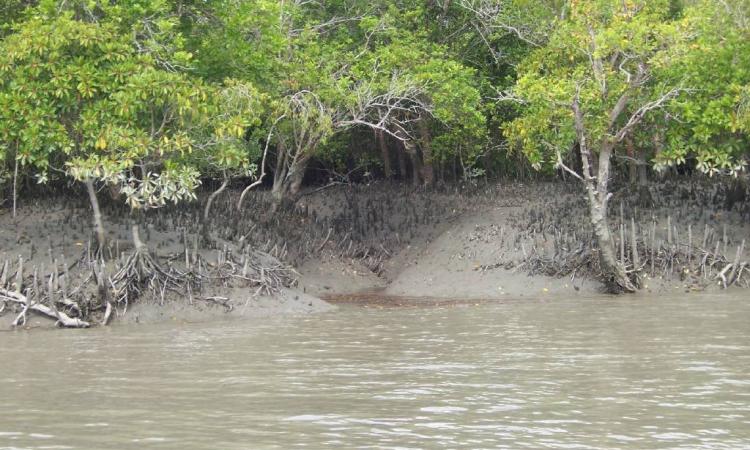
India’s 7500 km coastal line supports nearly 4, 87,100 hectares of mangroves. These unique ecosystems harbour nearly 3985 species of flora and fauna. Due to the increasing effects of climate change, mangrove forests in the country are under serious threat.
What are mangroves?
Mangroves are large and extensive collections of medium height trees and shrubs that grow in saline coastal sediment areas in the tropics and subtropics. Mangroves grow at the intersection of oceans, freshwater, and land. They are the most productive and complex ecosystems on the planet, growing under environmental conditions that would kill ordinary plants very quickly [1]. Mangrove forests support a wealth of life, from starfish to people, and are very important to the health of the planet [2].
Mangroves:
- act as buffer zones between the land and sea
- protect the land from erosion
- provide a natural shield against cyclones, disasters and protect the shorelines
- provide breeding and nursery grounds for a variety of marine animals
- harbour a variety of lifeforms like invertebrates, fish, amphibians, reptiles, birds and mammals like tigers
- provide a good source of timber, fuel and fodder
- are a main source of income generation for shoreline communities like fisherfolk
- save the marine diversity, which is fast diminishing.
- purify the water by absorbing impurities and harmful heavy metals and help to clean the air by absorbing pollutants
- provide a potential source for recreation and tourism [3]
The state of mangroves in India
The paper titled 'Impacts of Climate Change on Indian Mangroves: A Review Paper' published in the Global Journal of Environmental Research informs that Indian mangroves support a unique group of life. This includes fungi, microbes, plants and animal species including crustaceans, molluscs, fishes, water birds and a number of endangered mammals like fruit bats, dolphin and the Royal Bengal tiger.
The effects of climate change on mangroves
During the late 80s, India lost considerable areas of its mangrove cover to several anthropogenic pressures. The ongoing phenomenon of climate change has been predicted to pose a great threat to what’s left of the Indian mangroves and other coastal ecosystems. However, till date, there are no studies on the impacts of climate change on mangroves.
- Increased levels of Co2: Higher concentrations of Co2 can be deleterious for a number of mangrove species leading to substantial changes in vegetation along salinity and aridity gradients. However, the actual impact of Co2 on mangroves is poorly understood.
- Rising temperatures: Higher temperatures are predicted to have an impact on the species, and sea level rise can strongly affect the mangrove forests. Mangrove plants need an ideal temperature for photosynthesis (28-32°C), which can significantly reduce when leaf temperatures reach high levels of 38-40 °C, thereby affecting net productivity. It has been predicted that the mangroves could face species composition change as well as changes in the flowering and fruiting periods due to temperature changes. Continuous monitoring and detailed analysis indicate that the maximum temperature has been increasing during the last century over all the regions of India.
- Sea level rise: This probably is the greatest threat facing coastal mangroves. Recent studies have shown that larger changes in sea level can lead to mangrove ecosystem collapse. Increased intensity of cyclones has also been found to damage the mangroves through defoliation, uprooting of trees and death of trees. In addition to tree mortality, the nature of soil sediments also gets modified. It can also lead to ecosystem conversion. Studies also show that cleared mangrove forests fail to recover due to changed hydrodynamics, salinity and acidity as well as low nutrient levels and poor essential substrates.
- Reduced rainfall: It has been predicted that poor rainfall and increased evaporation can lead to rise in the salinity of mangroves leading to decreased productivity, poor seedling and growth survival. It can also lead to the decreased diversity of mangrove zones and may also cause reduction in mangrove area by altering competition of existing species.
The paper informs that as far as India is concerned, there are several lacunae in analysing or estimating the impacts climate change on mangrove forests. Pollution is on the rise and highly populated coastal metro cities like Mumbai, Chennai and Calcutta face increased pollution load resulting in the decrease in mangrove cover. Mangroves in Maharashtra are almost extinct now due to continuous human exploitation.
The ecological and the socioeconomic advantages offered by mangroves are innumerable, immeasurable and incomparable. The article ends by arguing that conserving mangroves should be on top of the conservation agenda of our country in the coming years.
References
1.Wetlands International (2014) Mangrove forests. Accessed on 23rd January 2015.
2. National Geographic (2015) Mangroves. Accessed on 23rd January 2015.
3. Soonabai Pirojsha Godrej Marine Ecology Centre (2015) Why should we protect mangroves? Accessed on 23rd January 2015.SAccessed on 23rd January 2015oonabai Pirojsha Godrej Marine Ecology CentreSoonaba Pirojsha Godrej Marine Ecology Centre
/articles/climate-change-threatens-indian-mangroves